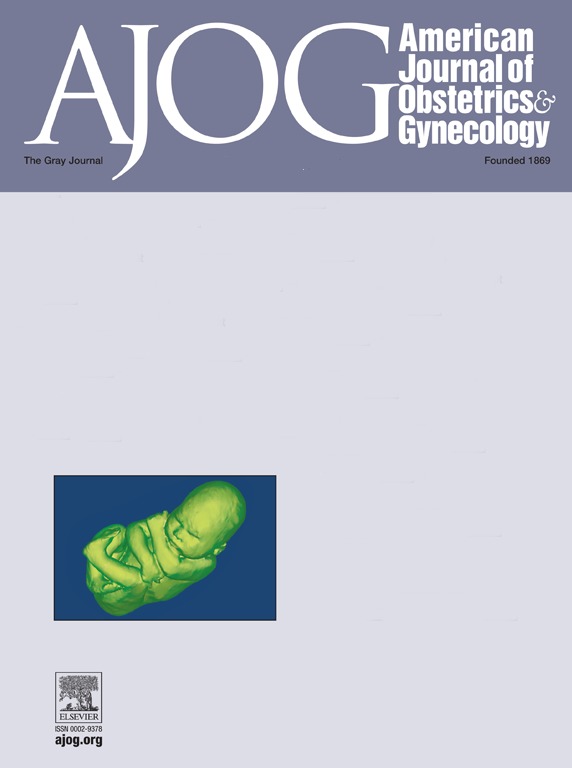Prenatal exposure to vaginal progesterone for the prevention of preterm birth is not associated with abnormal psychopathological and cognitive profiles in dichorionic twins at 6 to 9 years of age: a follow-up study of a randomized controlled trial.
IF 8.7
1区 医学
Q1 OBSTETRICS & GYNECOLOGY
引用次数: 0
Abstract
BACKGROUND Current evidence indicates that administration of vaginal progesterone to women with a twin gestation and a short cervix reduces the risk of preterm birth occurring at early gestational ages and of neonatal morbidity and mortality. However, the potential long-term effects of prenatal administration of vaginal progesterone for preventing preterm birth on the psychopathological and cognitive profiles of twins remain unknown. OBJECTIVE To evaluate the psychopathological and cognitive profiles at 6 to 9 years of age of surviving children born to mothers who participated in a randomized controlled trial that compared two different daily doses of vaginal progesterone (200 mg and 400 mg) to placebo to prevent preterm birth in dichorionic twin gestations. STUDY DESIGN This is a follow-up study from a multicenter, double-blind, randomized controlled trial with three parallel groups (placebo, vaginal progesterone 200 mg/day, and vaginal progesterone 400 mg/day administered from 20 to 34 weeks of gestation or delivery, whichever came first; randomization ratio 1:1:1). The Child Behavior Checklist for ages 6 to 18 questionnaire and the Raven's Colored Progressive Matrices test of non-verbal intelligence were applied to the participating mothers and their surviving children aged 6 to 9 years, respectively. The participant mothers, questionnaire collector, and database organizer were blinded to the intervention received in the original trial. The primary outcomes were behavioral, emotional, and social problems evaluated by the Child Behavior Checklist for ages 6 to 18 -18 questionnaire, and the intelligence coefficient percentile evaluated by the Raven's Colored Progressive Matrices test. Analyses were performed on an intention-to-treat basis using descriptive and analytical tests. P values <0.05 were considered statistically significant. RESULTS A total of 206 children born to 104 mothers (35.4% of those included in the original randomized controlled trial) were included in the study: 75 were exposed to vaginal progesterone 200 mg/d, 63 to vaginal progesterone 400 mg/d, and 68 to placebo. Overall, there were no significant differences in maternal sociodemographic, pregnancy and neonatal characteristics between participants and non-participants in the follow-up study, as well as between the three participating study groups. The mean scores of the 11 psychopathological syndrome scales evaluated by the Child Behavior Checklist for ages 6 to 18 questionnaire among children exposed to vaginal progesterone 200 mg/d, 400 mg/d or 200 & 400 mg/d were not significantly different to those among children exposed to placebo. There were no significant differences in the mean total Child Behavior Checklist score between the vaginal progesterone groups (31.08 ± 22.58 for the 200 mg/d group, 37.48 ± 28.59 for the 400 mg/d group, and 34.00 ± 25.60 for the 200 & 400 mg/d group) and the placebo group (34.60 ± 25.55) (P=0.38, 0.54, and 0.87, respectively). The mean percentiles of the Raven's test were slightly higher among children exposed to vaginal progesterone 200 mg/d (63.11 ± 27.03) and 400 mg/d (60.40 ± 31.51) than among those exposed to placebo (59.40 ± 30.64) although these differences were not statistically significant (P = 0.44 and 0.85, respectively). CONCLUSION Exposure to 200 or 400 mg/day of vaginal progesterone in the second half of pregnancy for preterm birth prevention, had no effect on the psychopathological and cognitive profiles of dichorionic twins at 6-9 years of age.产前接触阴道孕酮以预防早产与6至9岁双绒毛膜双胞胎的异常精神病理和认知特征无关:一项随机对照试验的随访研究
背景:目前的证据表明,双胎妊娠和短子宫颈妇女阴道使用黄体酮可降低早期妊娠期早产的风险以及新生儿发病率和死亡率。然而,产前给予阴道孕酮预防早产对双胞胎的精神病理和认知特征的潜在长期影响尚不清楚。目的:评估参加随机对照试验的母亲所生的6至9岁幸存儿童的精神病理学和认知特征,该试验比较了两种不同剂量的阴道黄体酮(200 mg和400 mg)与安慰剂,以预防双绒毛膜双胎妊娠的早产。研究设计:这是一项多中心、双盲、随机对照试验的随访研究,有三个平行组(安慰剂、阴道黄体酮200 mg/天和阴道黄体酮400 mg/天,从妊娠或分娩的20至34周,以先到者为准);随机化比例1:1:1)。分别采用6 ~ 18岁儿童行为表问卷和瑞文彩色递进矩阵非语言智力测验对参与调查的母亲及其6 ~ 9岁的在世子女进行测试。参与者母亲、问卷收集者和数据库组织者对原始试验中接受的干预措施不知情。主要结果为6 ~ 18岁儿童行为量表评估的行为、情绪和社会问题,以及瑞文彩色递进矩阵测验评估的智力系数百分位数。采用描述性和分析性测试,在意向治疗基础上进行分析。P值<0.05认为有统计学意义。结果104名母亲所生的206名儿童(占原始随机对照试验的35.4%)纳入研究:75名接受阴道黄体酮200 mg/d治疗,63名接受阴道黄体酮400 mg/d治疗,68名接受安慰剂治疗。总体而言,在随访研究中,参与者与非参与者之间,以及三个参与研究小组之间,产妇社会人口学、妊娠和新生儿特征均无显著差异。使用儿童行为检查表对6至18岁儿童进行11项精神病理综合征量表的平均得分评估,暴露于阴道黄体酮200mg /d、400mg /d或200mg & 400mg /d的儿童与暴露于安慰剂的儿童的平均得分无显著差异。阴道黄体酮组(200 mg/d组31.08±22.58,400 mg/d组37.48±28.59,200和400 mg/d组34.00±25.60)与安慰剂组(34.60±25.55)的儿童行为检查表平均总分比较,差异均无统计学意义(P分别为0.38、0.54和0.87)。阴道黄体酮200mg /d组(63.11±27.03)和400mg /d组(60.40±31.51)的雷文试验平均百分位数略高于安慰剂组(59.40±30.64),但差异无统计学意义(P分别为0.44和0.85)。结论妊娠后半期阴道孕酮剂量为200或400 mg/d对6-9岁双绒毛膜双胞胎的精神病理和认知特征无影响。
本文章由计算机程序翻译,如有差异,请以英文原文为准。
求助全文
约1分钟内获得全文
求助全文
来源期刊
CiteScore
15.90
自引率
7.10%
发文量
2237
审稿时长
47 days
期刊介绍:
The American Journal of Obstetrics and Gynecology, known as "The Gray Journal," covers the entire spectrum of Obstetrics and Gynecology. It aims to publish original research (clinical and translational), reviews, opinions, video clips, podcasts, and interviews that contribute to understanding health and disease and have the potential to impact the practice of women's healthcare.
Focus Areas:
Diagnosis, Treatment, Prediction, and Prevention: The journal focuses on research related to the diagnosis, treatment, prediction, and prevention of obstetrical and gynecological disorders.
Biology of Reproduction: AJOG publishes work on the biology of reproduction, including studies on reproductive physiology and mechanisms of obstetrical and gynecological diseases.
Content Types:
Original Research: Clinical and translational research articles.
Reviews: Comprehensive reviews providing insights into various aspects of obstetrics and gynecology.
Opinions: Perspectives and opinions on important topics in the field.
Multimedia Content: Video clips, podcasts, and interviews.
Peer Review Process:
All submissions undergo a rigorous peer review process to ensure quality and relevance to the field of obstetrics and gynecology.

 求助内容:
求助内容: 应助结果提醒方式:
应助结果提醒方式:


